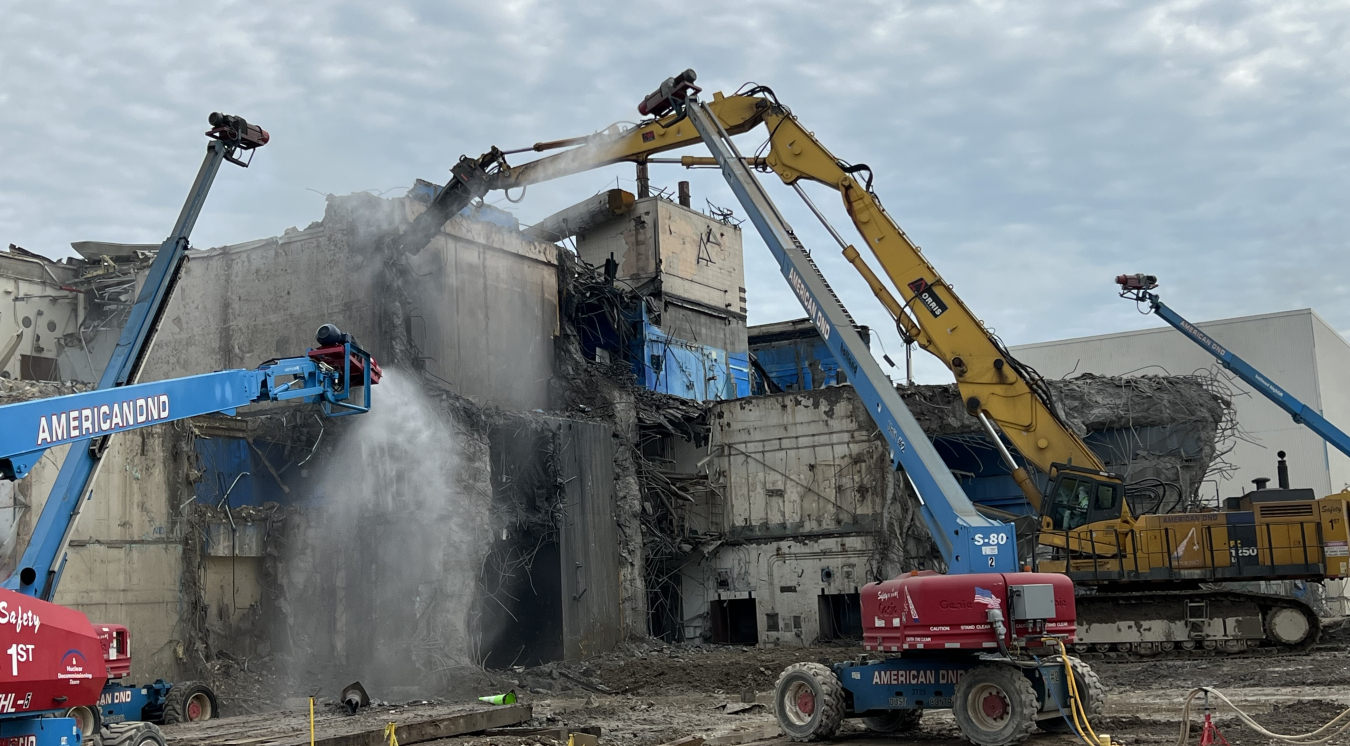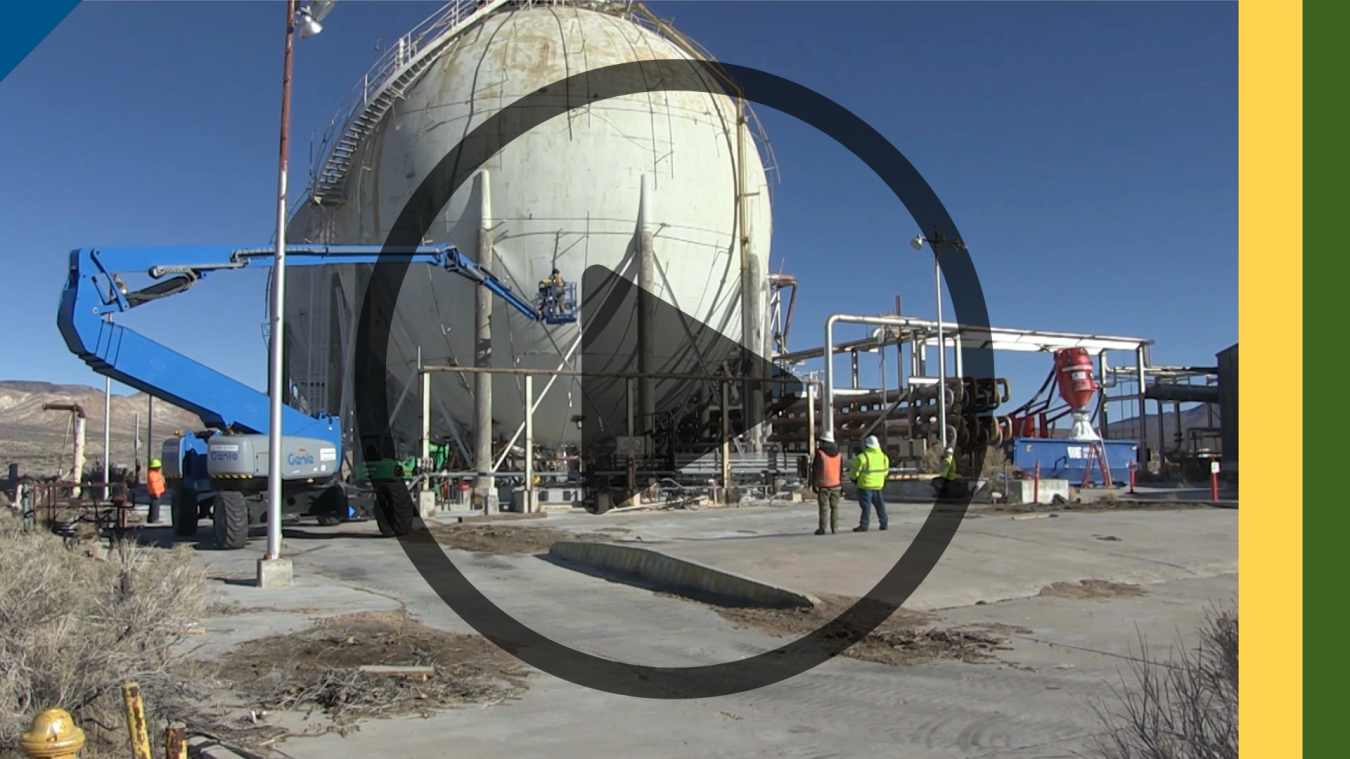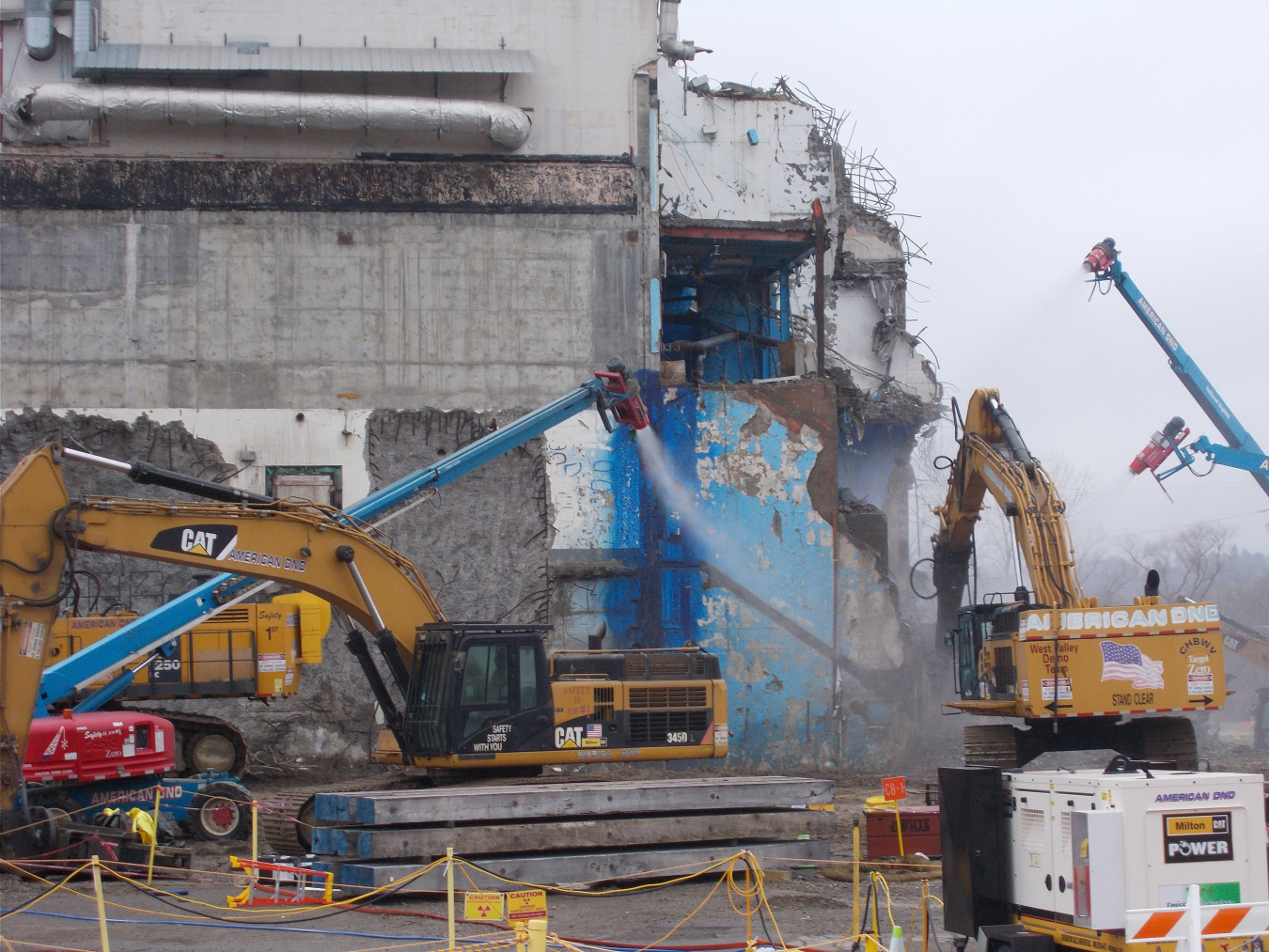
Using an excavator with a hydraulic claw, an operator at the West Valley Demonstration Project removes the Chemical Process Cell Crane Room bridge crane as workers spray water to control dust.
The Infrastructure and Deactivation & Decommissioning Office develops policy for deactivation & decommissioning, real property asset management, sustainability and energy management. The office leads the transfer of completed projects; manages the transfer of excess contaminated facilities and materials from National Nuclear Security Agency, Office of Science, and the Office of Nuclear Energy; and has the overriding responsibility to support field offices by enabling the effective execution of the mission.

Watch this video to learn more about the EM Nevada Program's preparations to begin demolition of the Engine Maintenance, Assembly, and Disassembly and Test Cell C facilities at the Nevada National Security Site.
Only process contaminated excess facilities and wastes are D&D by EM. Process contamination refers to contamination, radioactive and/or chemical, resulting from mission operations and not from construction activities and associated materials, such as, but not limited to, asbestos, lead-based paint and polychlorinated biphenyls (PCBs) in light ballasts, and/or transformers. Excess means the facility has no more purpose or use under DOE’s Mission.
Following operational shutdown and transition the first disposition activity is usually to deactivate the facility. The purpose of the deactivation mission is to place a facility in a safe shutdown condition that is economical to monitor and maintain for an extended period until the eventual decommissioning of the facility. Deactivation places the facility in a low-risk state with minimum surveillance and maintenance requirements. Once deactivation is complete, the final facility disposition activity is decommissioning, where the facility is taken to its ultimate end state through decontamination and/or dismantlement to demolition or entombment. After decommissioning is complete, the facility or surrounding area may require DOE control for protection of the public and the environment or for environmental remediation. An important objective throughout transition and disposition is to continue to maintain an integrated and seamless process linking deactivation, decommissioning and surveillance and maintenance.

Deactivation is the process of placing a contaminated (nuclear, radiologically or radioactive), excess facility in a stable condition to minimize existing risks and protect workers, the public and the environment. Decommissioning is the final process of closing and securing the facility consistent with established end states, to provide adequate protection from radiation exposure and isolation from the human environment. The D&D process includes the removal of hazardous and radioactive materials to ensure adequate protection of workers, public health and safety, and the environment; placing the facility in a stable condition, thereby limiting the long-term cost of surveillance and maintenance, after which, demolition/disposition occurs. D&D presents unique hazards that must be addressed from a safety, programmatic, environmental and technological standpoint.
Deactivation & Decommissioning Knowledge Management Information Tool (D&D KM-IT)

Sustainability at EM means making improvements in the areas of environmental, energy, water, waste management, and economic performance thus bringing positive outcomes to the EM field sites and their local communities. EM promotes sustainability, natural/cultural resource preservation and the integration of sustainable practices within its management functions and mission activities. Infrastructure resilience at EM means looking at strategies and procedures that identify and respond to significant events with the potential to disrupt, strain or compromise activities or facilities and infrastructure.

Facility and infrastructure within EM encompasses real property asset management across the complex as well as the transfers of real property that is not needed or excessed for DOE mission to Community Reuse Organizations and other entities for asset revitalization and/or economic development reuse.
EM’s Federal Fleet Management effectively and efficiently meets the statutes set forward in Executive Orders and 41 CFR 109 DOE Property Management Regulations, specifically 41 CFR 109-38 Motor Equipment in working with the Site Offices, and the DOE Office of Asset Management and General Service Administration. Additionally, the DOE Handbook on Fleet Management, DOE-HDBK-7251-2016 dated September 2016, is available on the DOE Technical Standards Program website. The purpose of this Handbook is to provide information, procedures, methods and practices that may be used in the life -cycle management of motor vehicles, motor equipment and watercraft assigned to the DOE’s Fleet.
Real Property Asset Management, EM carries out stewardship responsibilities and ensures that facilities and infrastructure are properly sized and in a condition to meet EM mission requirements. Real property including land parcels, which are not needed for DOE’s mission, are transferred, where applicable (varies by site), to the private sector including Community Reuse Organizations and local government for asset revitalization, economic development reuse or conservation purpose, pursuant to Atomic Energy Act, as amended, and 10 CFR 770.
Any non-transferable EM real property is placed in long-term surveillance and monitoring under the DOE Office of Legacy Management. EM also disposes of excess uncontaminated facilities and excess land parcels through transfer out of DOE real estate portfolio by sale across the DOE sites. DOE Facility Information Management System database serves as the DOE's source of information on all real property holdings including owned and leased.
DOE O 430.1C, establishes an integrated Secretarial-Site-Contractor’s level, performance-based approach to the life-cycle management of real property assets. It links real property asset planning, programming, budgeting and evaluation to the Department's multi-faceted missions.
Deactivation & Decommissioning News
-
U.S. Department of Energy Office of Environmental Management decontamination and demolition crews are using innovative technologies and techniques to safely and efficiently demolish two defueled naval nuclear propulsion plant prototypes at the Naval Reactors Facility at the Idaho National Laboratory Site.October 15, 2024
-
Cleanup crews are making steady progress on deactivation projects across Oak Ridge National Laboratory to prepare for the next wave of demolitions as they continue transforming the site.October 1, 2024
-
For the first time in 70 years, crews at the U.S. Department of Energy Office of Environmental Management Paducah Site recently opened storage tanks used in the uranium enrichment process.October 1, 2024
-
Crews at Oak Ridge recently achieved a U.S. Department of Energy Office of Environmental Management 2024 priority by initiating demolition on a facility in the Manhattan Project-era Alpha-2 complex at the Y-12 National Security Complex.September 17, 2024
-
Crews are reducing risk at the Reduction Oxidation Plant, one of five former plutonium production facilities at the Hanford Site.September 17, 2024
-
The U.S. Department of Energy Office of Environmental Management (EM) and its cleanup contractor at the West Valley Demonstration Project recently notched an annual cleanup priority ahead of schedule for a second consecutive yearSeptember 3, 2024

